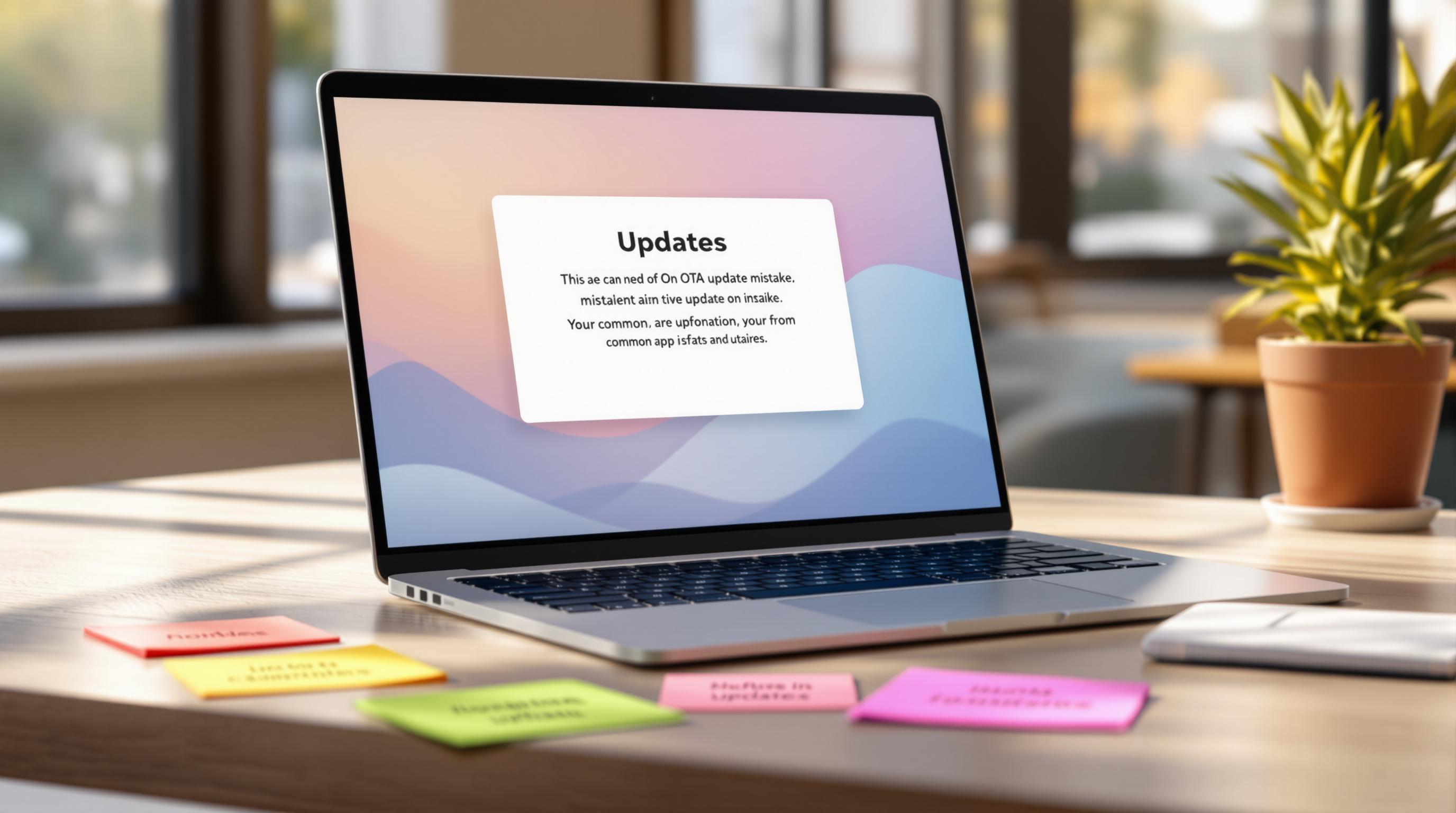Want to integrate Android features into your Capacitor app? This guide explains how to use AAR (Android Archive) files in Capacitor plugins to combine native Android functionality with cross-platform web apps.
Key Takeaways:
- What are AAR files? Pre-packaged Android libraries containing code, resources, and native files.
- Why use them? AAR files enable code reuse, simplify maintenance, and protect proprietary features.
- What’s required? Tools like Android Studio, Gradle, and Node.js, plus proper project setup.
- How to integrate? Place AAR files in
libs, configure Gradle, and connect them to Capacitor plugins.
Quick Steps:
- Set up your environment: Install required tools and configure Android Studio.
- Organize your project: Create a clear structure for your Capacitor plugin.
- Add AAR files: Place them in
android/libsand update Gradle dependencies. - Write plugin code: Link AAR functionality to JavaScript with Capacitor’s API.
- Test thoroughly: Use Android Studio’s debugger to ensure smooth integration.
By following this guide, you can seamlessly incorporate AAR files into your Capacitor plugins, unlocking native Android capabilities for your web apps.
How to embed an Android library (AAR file) into a capacitor plugin

Development Setup Requirements
Before working with AAR files, make sure your development environment is properly configured to avoid any hiccups.
Required Software
Here’s the software you’ll need to work with AAR files in Capacitor plugins:
| Software | Minimum Version | Purpose |
|---|---|---|
| Android Studio | 2022.1.1 or higher | The main IDE for Android development |
| Java Development Kit | 11 or higher | Required for Android development |
| Node.js | 14.0 or higher | For managing Capacitor and npm packages |
| Gradle | 7.3 or higher | Android’s build tool |
| Git | 2.30 or higher | For version control and package management |
Additionally, make sure the following components are included in your SDK Manager:
- Android SDK Platform 33 (Android 13.0)
- Android SDK Build-Tools 33.0.0
- Android SDK Command-line Tools
- Android Emulator
- Android SDK Platform-Tools
Project Setup Steps
1. Initialize Your Development Environment
Start by creating a new directory with this structure:
my-plugin/├── android/│ ├── src/│ └── build.gradle├── src/│ └── definitions.ts└── package.json2. Configure Android Studio Settings
Launch Android Studio and adjust the following settings:
- Set the Gradle JDK to version 11 or higher.
- Enable the auto-download feature for Android SDK components.
- Update your system environment variables with the correct Android SDK path.
3. Prepare Your Plugin Structure
Update the android/build.gradle file with these settings to include AAR file support:
android { compileSdkVersion 33 defaultConfig { minSdkVersion 22 targetSdkVersion 33 }
repositories { flatDir { dirs 'libs' } }}4. Set Up Version Control
Initialize Git in your project directory and create a .gitignore file to exclude unnecessary files. Here’s a sample .gitignore:
android/build/node_modules/dist/*.iml.idea/.gradle/local.propertiesOnce these steps are complete, you’ll be ready to move on to adding your AAR files.
Adding AAR Files to Your Plugin
Getting AAR Files
AAR files can come from third-party SDKs, custom libraries, or Maven dependencies. It’s a good idea to document their source, version, and purpose in a README file located in the libs directory.
| Source Type | Description | Best Practice |
|---|---|---|
| Third-party SDKs | Pre-compiled libraries from vendors | Document vendor version details in a README |
| Custom Android Libraries | Self-developed Android modules | Document the build process |
| Maven Dependencies | Converted from remote repositories | Cache locally for offline builds |
Once your AAR files are ready and documented, you can configure your plugin to include them.
Setting Up Plugin Files
Organize your plugin files to ensure smooth integration of AAR dependencies. Here’s an example of how your plugin structure might look:
my-plugin/├── android/│ ├── libs/ # AAR files with README│ ├── src/│ └── build.gradle├── src/│ └── definitions.ts└── package.json{ "files": [ "android/libs/*.aar", "android/src/**/*", "src/**/*" ]}AAR File Placement
To enable AAR functionality, place the files in the android/libs directory of your plugin following these steps:
- Use a clear and consistent naming format, such as
libraryname-version.aar. - Manage versions in a
versions.propertiesfile. For example:
library1=1.2.3library2=2.0.0- Add a
dependencies.gradlefile for other dependencies:
dependencies { implementation fileTree(dir: 'libs', include: ['*.aar']) implementation 'com.example:dependency:1.0.0'}- Organize vendor-specific files into subdirectories for better management:
android/libs/├── vendor1/│ ├── feature.aar│ └── config.json└── vendor2/ ├── module.aar └── settings.xmlKeeping configuration files in vendor-specific subdirectories helps maintain organization and avoids build conflicts when working with multiple AAR dependencies.
Gradle Configuration Steps

Updating build.gradle
To integrate AAR files into your Capacitor plugin, you need to configure Gradle appropriately. Start by adding these repository settings to android/build.gradle:
repositories { google() mavenCentral() flatDir { dirs 'libs' }}Then, include the AAR dependencies in the dependencies block:
dependencies { implementation files('libs/your-library.aar') implementation fileTree(dir: 'libs', include: ['**/*.aar']) implementation "com.getcapacitor:core:${capacitorVersion}" implementation "androidx.appcompat:appcompat:1.6.1"}For better version management, create a gradle.properties file in your project root and define your library versions:
# Library versionsMY_LIBRARY_VERSION=1.2.3CAPACITOR_VERSION=5.5.0If the AAR file comes with additional dependencies, declare them in android/build.gradle like this:
android { defaultConfig { minSdkVersion 21 targetSdkVersion 33 }
packagingOptions { exclude 'META-INF/DEPENDENCIES' exclude 'META-INF/LICENSE' }}Once you’ve made these changes, sync your project to apply them.
Running Gradle Sync
Open your project in Android Studio and wait for Gradle to sync automatically. If it doesn’t start, click the “Sync Project with Gradle Files” button in the toolbar.
After syncing, verify the following:
| Check Point | Expected Result | Common Issues |
|---|---|---|
| Build Output | No AAR-related errors | Missing dependencies |
| Library Resolution | AAR files properly linked | Incorrect path references |
| Version Conflicts | No dependency version issues | Incompatible versions |
If the sync fails, double-check your configuration. For instance, ensure these settings are in place:
android { compileOptions { sourceCompatibility JavaVersion.VERSION_1_8 targetCompatibility JavaVersion.VERSION_1_8 }
lintOptions { abortOnError false }}For large AAR files, you may need to increase Gradle’s memory allocation in gradle.properties:
org.gradle.jvmargs=-Xmx2048m -XX:MaxPermSize=512mOnce the sync completes successfully, your AAR files should be fully integrated and ready for testing.
Connecting AAR Features to Capacitor
Writing the Plugin Class
Once your Gradle files are synced, it’s time to connect your AAR functionality by extending the Plugin class. This step links JavaScript to the native Android code.
@NativePlugin( permissions = { Manifest.permission.REQUIRED_PERMISSION })public class YourPlugin extends Plugin { private YourAARLibrary libraryInstance;
@Override public void load() { super.load(); libraryInstance = new YourAARLibrary(getContext()); }}Here’s what you need for initializing the AAR library:
| Component | Purpose | Implementation Note |
|---|---|---|
| Context | Android app context | Use getContext() from the Plugin class |
| Configuration | Library settings | Pass options from the plugin |
| Lifecycle | Plugin state management | Override load() and handleOnDestroy() |
Creating Plugin Methods
Next, define methods in your plugin using the @PluginMethod annotation. These methods handle data exchange between JavaScript and Java.
@PluginMethodpublic void performAction(PluginCall call) { try { // Get data from JavaScript String inputData = call.getString("inputKey");
// Call AAR library method YourLibraryResult result = libraryInstance.processData(inputData);
// Return result to JavaScript JSObject ret = new JSObject(); ret.put("value", result.getValue()); call.resolve(ret); } catch (Exception e) { call.reject("Error processing data", e); }}For tasks that need to run asynchronously:
@PluginMethod(returnType = PluginMethod.RETURN_CALLBACK)public void startContinuousOperation(PluginCall call) { call.setKeepAlive(true);
libraryInstance.setCallback(new LibraryCallback() { @Override public void onUpdate(String data) { JSObject ret = new JSObject(); ret.put("data", data); call.resolve(ret); } });}Here’s how common types are converted between JavaScript and Java:
| JavaScript Type | Java Type | Conversion Method |
|---|---|---|
| Object | JSObject | call.getObject() |
| Array | JSArray | call.getArray() |
| String | String | call.getString() |
| Number | Integer/Double | call.getInt()/call.getDouble() |
| Boolean | Boolean | call.getBoolean() |
For resource cleanup, override the handleOnDestroy method:
@Overrideprotected void handleOnDestroy() { if (libraryInstance != null) { libraryInstance.cleanup(); libraryInstance = null; } super.handleOnDestroy();}With these methods in place, your native bridge is ready. Test your implementation in Android Studio’s debug environment to ensure everything works as expected.
Testing and Fixing Issues
Debugging in Android Studio

To debug your AAR integration in Android Studio, start by enabling debug mode in your project’s build.gradle file:
android { buildTypes { debug { debuggable true minifyEnabled false } }}Add breakpoints in your plugin methods to track the data flow and identify potential issues:
@PluginMethodpublic void yourMethod(PluginCall call) { // Set a breakpoint here to inspect input data String inputValue = call.getString("key"); // Another breakpoint here to check method calls to the AAR libraryInstance.someMethod(inputValue);}Use the Debug panel in Android Studio to monitor key areas:
| Debugging Area | What to Check | Common Issues |
|---|---|---|
| Logcat | AAR initialization messages | Missing permissions or incorrect context |
| Variables | Data type conversions | Null values or type mismatches |
| Stack Trace | Method execution flow | Invalid method calls or threading issues |
| Memory | Resource usage | Memory leaks |
If debugging doesn’t resolve the issue, follow the troubleshooting steps in the next section.
Troubleshooting Steps
When debugging alone isn’t enough, use these steps to address common problems:
1. Dependency Conflicts
Check for version conflicts in your build.gradle file. You can force specific versions to resolve conflicts:
configurations.all { resolutionStrategy { force 'com.google.android:android:4.1.1.4' // Add other forced versions as needed }}2. Missing Native Libraries
Ensure the AAR includes the required .so files in the appropriate directories, such as:
jniLibs/armeabi-v7a/jniLibs/arm64-v8a/jniLibs/x86/jniLibs/x86_64/
3. Manifest Merger Issues
If you encounter manifest conflicts, include the following in your AndroidManifest.xml file to override problematic libraries:
<manifest xmlns:android="http://schemas.android.com/apk/res/android" xmlns:tools="http://schemas.android.com/tools" package="your.plugin.package"> <uses-sdk tools:overrideLibrary="conflicting.library.package"/></manifest>4. Runtime Crashes and Memory Management
Use the Performance tab in Android Studio to monitor runtime stability. For initialization issues, handle exceptions carefully:
try { libraryInstance = new YourAARLibrary(getContext());} catch (Exception e) { Log.e("PluginError", "Failed to initialize library: " + e.getMessage()); return;}To prevent memory leaks, ensure resources are released properly. Use the Memory Profiler in Android Studio to track heap usage and identify any leaks.
Summary
To integrate AAR files into Capacitor plugins, you’ll need to set up the Android environment, place AAR files correctly, configure Gradle accurately, and test thoroughly.
Key Implementation Phases
| Phase | Requirements | Indicators of Success |
|---|---|---|
| Development Setup | Android Studio 4.0+, Gradle 7.0+ | Build completes without errors |
| AAR Integration | Proper file placement, correct dependencies | No manifest conflicts |
| Plugin Development | Clear plugin structure, accurate method mapping | Methods execute as expected |
| Testing | Debug mode active, effective error handling | No runtime crashes |
Once you’ve mastered these basics, you can explore more advanced techniques.
Next Steps
To enhance your plugin, focus on these areas:
-
Performance Optimization
Use Android Studio’s profiler to monitor memory usage and ensure resources are cleaned up properly. -
Distribution Preparation
Document all AAR configurations, generate API documentation, and test compatibility with Android API levels 29–34. -
Maintenance Strategy
Automate testing, manage AAR versions with version control, maintain a changelog, and set up error reporting to address production issues.
If you plan to share your plugin publicly, make sure to provide detailed documentation on AAR-specific setups and any platform limitations. This will make it easier for other developers to adopt and use your plugin effectively.




